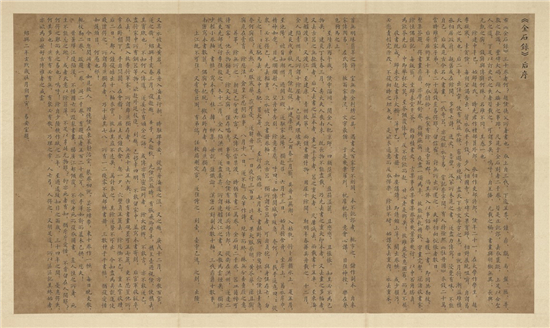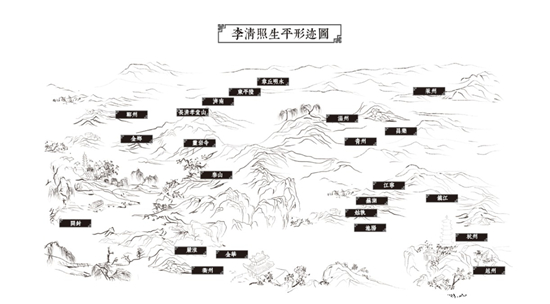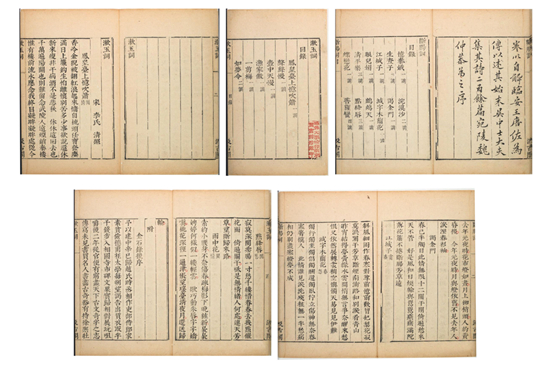婉约词宗——李清照
李清照,自号易安居士,山东章丘明水人。生于公元1084年,卒年不详。据近人考证,当卒于公元1155年以后,享年七十余岁。她出生于书香门第,早期生活优裕,父亲李格非,是著名的《洛阳名园记》的作者,曾以文章受知于苏轼。母亲王氏也知书能文。良好的家庭环境使其打下坚实的文学基础。李清照自少便有诗名,她于十八岁时,与太学生赵明诚结婚。赵明诚婚后曾出任莱州、淄川等地太守。她们夫妇都爱好诗词,时相唱和,还酷爱金石图书,节衣缩食,收藏极富。赵明诚撰《金石录》一书,李清照亦曾笔削其间。靖康变起,其与赵明诚渡淮南奔,金石书画大部丧失。公元1129年,赵明诚病死于建康(今南京)。此后,李清照便辗转漂流于杭州、越州、台州和金华一带,在颠沛流离的孤苦生活中度过了她的后半生。李清照的平生事迹见于载籍的并不多,公元1134年,李清照撰《金石录后序》,追述了她婚后至五十一岁以前的生活景况和各种遭际,是了解李清照生平的直接史料。公元1143年前后,李清照将赵明诚遗作《金石录》校勘整理,表进于朝。越十余年,大约在公元1156年或者以后,李清照怀着对死去亲人的绵绵思念和对故土难归的无限失望,在极度孤苦、凄凉中,悄然辞世,卒年不明,不能早于绍兴二十五年,享年至少73岁。
Li Qingzhao (pseudonym: Householder of Yi’an), from Mingshui, Zhangqiu, Shandong, was born in 1084. According to modern research, she died sometime after 1155, having lived to her 70s. She was born into an affluent family of scholars. Her father, Li Gefei, wrote the famous piece Famous Gardens of Luoyang, and his work even caught the attention of the famous Su Dongpo. Her mother, surnamed Wang, was also educated, a rarity for women of the time. Such a family gave Li Qingzhao a strong literary foundation, allowing her to gain fame for her poetry at an early age. When she was 18, she married Zhao Mingcheng, a graduate of the Imperial College who later became prefect of Laizhou and Zichuan. The two shared a love of poetry, frequently writing and enjoying poetry together, had a passion for collecting ancient inscriptions on bronze and stone tablets, dressed and ate frugally, and accumulated a massive collection of literary artifacts from the past. Zhao wrote Records of Bronze and Stone Inscriptions, and Li contributed to it as well. To escape the chaos of the 1127 Jingkang Incident, the couple crossed the Huai River and headed south, leaving many of their bronze and stone relics behind to be destroyed. Two years later, Zhao died of illness in Jiankang (present-day Nanjing), after which Li began a period of drifting among the regions of Hangzhou, Yuezhou, Taizhou, and Jinhua, living alone and helpless for the latter half of her life. There is little documentation of her life, but she wrote an afterword to Records of Bronze and Stone Inscriptions in 1134 (at the age of 51), in which she gives an account of her life, including her many misfortunes, from the time of her marriage. In 1143, she revised and organized the writings of her husband’s book into a final draft, which was commended by the imperial court. In about 1156 or thereafter, full of despair about the loss of her beloved husband and the inability to return to her hometown, as well as being plagued with extreme loneliness and sorrow, she passed away. Though the exact date is unknown, it could not have been earlier than 1155 (at which time she was 73).
李清照是中国古代罕见之才女,擅书、画,通金石,尤精诗词。她的词作独步一时,流传千古,被誉为“词家一大宗”。她的词分前期和后期。前期多写其悠闲生活,多描写爱情生活、自然景物,韵调优美,如《一剪梅·红藕香残玉簟秋》等,后期多慨叹身世,怀乡忆旧,情调悲伤,如《声声慢·寻寻觅觅》。其词作形式上善用白描手法,自辟蹊径,语言清丽。论词强调协律,崇尚典雅,提出词“别是一家”之说,反对以作诗文之法作词。能诗,留存不多,部分篇章感时咏史,情辞慷慨,但与其词风不同。正是她独特的艺术风格奠定了其在中国文学史上的重要地位。
Li is one of the few talented female writers of pre-modern China. She was good at calligraphy and painting, highly knowledgeable on ancient bronze and stone inscriptions, and especially excelled at poetry and ci lyric poetry. Her ci lyric poetry was unparalleled in its time and has received wide praise ever since, hence her being hailed as a master of this art form. Her ci lyric poetry may be divided into early and late work. Her early work focused mainly on her life of leisure, including love and natural scenery. The rhyme in this work is elegant, as exemplified by “Sprig of Plum Blossoms.” Her later work, such as “Slow Tune,” is characterized by lament for her plight and a longing for her hometown and the past. Her unique style was straightforward, and she employed elegant and beautiful language. In her work Lunci (“on ci lyric poetry”), she emphasizes harmony, refinement, and the idea that ci lyric poetry is different than other forms of poetry, thus advocating that the former should not be written in the same way as the latter. She produced work in other forms of poetry too, though not much remains to the present. Some of it expressed her feelings on current affairs and history. Her style in these poems is impassioned and liberal but different from her ci lyric poetry. It was precisely her unique style that established her important place in the history of Chinese literature.

李清照三十一岁画像
Portrait of Li Qingzhao at the age of 31.

李清照酴醾春去图照(晚清)
Li Qingzhao’s “Rubus Coronarius During the Fading of Spring” (late Qing dynasty).

多种版本的金石录影印本
Copies of various versions of Records of Bronze and Stone Inscriptions.
《金石录》简介
《金石录》,共三十卷,先由宋代赵明诚撰写大部分,高宗建炎三年(1129年),《金石录》已初具规模,赵明诚却不幸罹疾身亡,李清照寓居临安,历经坎坷经两年之余对遗稿作最后的笔削整理,才得完成。
Records of Bronze and Stone Inscriptions
Records of Bronze and Stone Inscriptions consists of 13 scrolls. Most of it was written by Zhao Mingcheng by 1129, but he soon died of illness. After two years of a difficult life in Lin’an, Li decided to polish and organize her husband’s work, producing its final form.
《金石录》一书,著录其所见从上古三代至隋唐五代以来,钟鼎彝器的铭文款识和碑铭墓志等石刻文字,是中国最早的金石目录和研究专著之一,发扬了以金石证史的治学传统,在金石研究上具有继往开来的意义,对史学、考据学、文献整理和金石书法的研究,亦是李清照在史学研究上作出的巨大贡献,至今具有重要的参考价值。
The book documents inscriptions on bronze vessels and stone tablets and gravestones from a period spanning the Xia dynasty (ca. 2070 – 1600 BCE) to the Tang dynasty (618 – 907 CE), making it the earliest catalog and textual study on the subject and serving to promote historical verification via these objects. It has played an important role in the continued research of these objects. In terms of historiography, textology, literature review, and calligraphy of the bronze and stone inscriptions, the book represents Li’s major contribution to historical research, and it is still a valuable reference to this day.

李清照《金石录》后序
Li Qingzhao’s Afterword to Records of Bronze and Stone Inscriptions.

李清照年谱
Chronology of Li Qingzhao’s life.

李清照形迹图
Places Li Qingzhao traveled.

李清照主要作品
Major works by Li Qingzhao.
李清照代表诗词
Li Qingzhao’s Greatest Ci Lyric Poems
如梦令
常记溪亭日暮,沉醉不知归路。
兴尽晚回舟,误入藕花深处。
争渡,争渡,惊起一滩鸥鹭。
如梦令
昨夜雨疏风骤,浓睡不消残酒。
试问卷帘人,却道海棠依旧。
知否,知否?
应是绿肥红瘦。
一剪梅
红藕香残玉簟秋。轻解罗裳,独上兰舟。
云中谁寄锦书来,雁字回时,月满西楼。
花自飘零水自流。一种相思,两处闲愁。
此情无计可消除,才下眉头,却上心头。
醉花阴
薄雾浓云愁永昼,瑞脑消金兽。
佳节又重阳,玉枕纱橱,半夜凉初透。
东篱把酒黄昏后,有暗香盈袖。
莫道不销魂,帘卷西风,人比黄花瘦。
声声慢
寻寻觅觅,冷冷清清,凄凄惨惨戚戚。
乍暖还寒时候,最难将息。
三杯两盏淡酒,怎敌他、晚来风急?
雁过也,正伤心,却是旧时相识。
满地黄花堆积。
憔悴损,如今有谁堪摘?
守着窗儿,独自怎生得黑?
梧桐更兼细雨,到黄昏、点点滴滴。
这次第,怎一个愁字了得!
乌江
生当作人杰,死亦为鬼雄。
至今思项羽,不肯过江东。
李清照人格如其作品,令人崇敬,被誉为“词国皇后”,曾“词压江南,文盖塞北”。自明朝以来,中国出现了四处“李清照纪念馆(堂)”和多处“藕神祠”。
Female poet Li Qingzhao possessed a character as admirable as her work. She was hailed as the “queen of the ci lyric poetry realm,” and her work has been known as some of the best in all of China. Since the Ming dynasty (1368 – 1644), four memorial halls and numerous shrines have been built in honor of her.
山东章丘纪念馆
章丘清照园位于明水百脉泉畔, 占地总面积为1.8万平方米,其中房屋建筑1270平方米,水面1500平方米,绿地1万平方米。于1997年5月1日正式开放。
Memorial Hall in Zhangqiu, Shandong
The Qingzhao Garden, located near the Baimai Springs in Mingshui District, Zhangqiu, covers an area of 18,000 square meters. The memorial hall covers 1,270 square meters, water covers 1,500 square meters, and greenery covers 10,000 square meters. It officially opened on May 1, 1997.
山东青州纪念馆
青州李清照纪念馆位于青州古城西门外洋溪湖畔。占地约630平方米。建筑坐北朝南,大门内有甬道北去,道东建有顺河楼,西边为四松亭,均为清代建筑。甬道尽头为一四合院,系1993年所建,门上书有著名词人萧劳书写的匾额“李清照纪念馆”。
Memorial Hall in Qingzhou, Shandong
The Li Qingzhao Memorial Hall in Qingzhou sits beside Yangxi Lake, outside of the western gate of the ancient walled city. It occupies an area of 630 square meters and faces south. Inside the gate is a path that heads north. To the east of the path is the Shunhe Building and to the west is the Sisong Pavilion, both having been built during the Qing dynasty. At the end of the path is a quadrangle built in 1993. Above the gate to the quadrangle is a horizontal board that reads “Li Qingzhao Memorial Hall” in characters written by the famous ci lyric poet Xiao Lao.
山东济南纪念堂
济南李清照纪念堂设在趵突泉公园内、 柳絮泉北侧的一处庭院中,总面积约为360平方米。这一庭院北宋时为济南盛族张氏的庭院,到了金代改为灵泉庵,清末改为咸丰进士山东巡抚丁宝祯的祠堂。因清代初期诗人田雯一首《柳絮泉访李易安故宅》诗,人们误认李清照故居即在柳絮泉边,其后文人墨客皆牵合附会,遂有李清照故宅在济南之说。
Memorial Hall in Jinan, Shandong
The Li Qingzhao Memorial Hall in Jinan, located in a courtyard to the north of the Liuxu Spring in the Baotu Spring Park, covers 360 square meters. The courtyard belonged to the rich and powerful Zhang clan of the Northern Song dynasty (960 – 1120). During the Jurchen Jin dynasty (1115 – 1234), it was made into the Lingquan Convent. Then during the late Qing dynasty (1644 – 1911), it was turned into a shrine to Ding Baozhen, who had passed the Palace Examination during the Xianfeng Emperor’s reign and had served as governor of Shandong. Because of a poem entitled “Visits the Home of Li Yi’an by the Liuxu Spring” (“Yi’an” was Li Qingzhao’s pseudonym) by the early Qing-dynasty poet Tian Wen, people mistakenly believed Li had lived in a house beside the spring. This misconception that Li had lived in Jinan spread among writers and calligraphers.
浙江金华纪念堂
金华李清照纪念堂设在金华市南隅八咏路八咏楼上。八咏楼,原名玄畅楼,又名元畅楼,为南朝齐隆昌元年(494年)东阳太守沈约修建,1994年,八咏楼文物保护管理所将八咏楼正厅改为李清照纪念堂。
Memorial Hall in Jinhua, Zhejiang
The Li Qingzhao Memorial Hall in Jinhua is in the Bayong Building on Bayong Road, in the southern part of the city. The edifice, named the Xuanchang Building and Yuanchang Building in the past, was built in 494 by the Dongyang prefect Shen Yue. In 1994, the Bayong Building Cultural Relic Preservation Office turned the main hall into a memorial hall for Li.
李清照曾被尊为藕花神,供奉于济南大明湖畔的藕神祠。自清代起,济南人民就将李清照封为藕神以祭祀。
Li was named the Lotus Goddess by the people of Jinan during the Qing dynasty. They worshiped her and built a shrine to her on the banks of Lake Daming in Jinan.
亲爱的朋友们!山东是一个文明现代、山川壮丽、历史悠久、人文荟萃的地方,位于中国东部沿海、黄河下游,与韩国、日本隔海相望,地处“一带一路”东端交汇点,曾诞生过孔子、孟子、曾子、子思以及墨子、孙子等一批中国思想文化巨人,GDP位居中国第三,人口超过1亿。
Dear friends, Shandong boasts modern civilization, magnificent mountains and rivers, time-honored history and a galaxy of talents. It is located on the eastern coast of China, at the lower reaches of the Yellow River, across the sea from South Korea and Japan, and at the juncture of the eastern section of “Belt and Road”. It’s the birthplace of a group of thinkers and contributors to Chinese culture, such as Confucius, Mencius, Zengzi, Zisi, Mozi, and Sunzi. Shandong has the third highest GDP in China, with a population of over 100 million.
2020年中国山东省要在全球招募2万名“孔子文化和旅游使者”,欢迎大家一起来了解“孔子家乡·好客山东”。
Shandong is to recruit 20,000 “Confucius Culture and Tourism Envoy” from all around the world. Join us to know about “Friendly Shandong, the home of Confucius”.
我们期待在“孔子家乡·好客山东”与你相遇!
We look forward to meeting you in Shandong.

山东省文化和旅游厅
Shandong Provincial Department of Culture and Tourism

